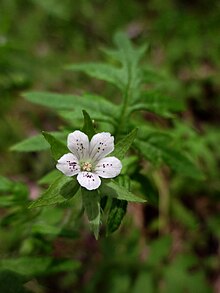Ellisia
| Ellisia | |
|---|---|

| |
| Scientific classification | |
| Kingdom: | Plantae |
| Clade: | Tracheophytes |
| Clade: | Angiosperms |
| Clade: | Eudicots |
| Clade: | Asterids |
| Order: | Boraginales |
| Family: | Boraginaceae |
| Subfamily: | Hydrophylloideae |
| Genus: | Ellisia L. |
| Species: | E. nyctelea |
| Binomial name | |
| Ellisia nyctelea | |
| Synonyms[2] | |
Ellisia is a genus of flowering plants in the forget-me-not family (Boraginaceae), containing the sole species Ellisia nyctelea.[3] It is native to North America, where it is also known as Aunt Lucy, false baby blue eyes, and waterpod.[2] The genus was named in honor of British naturalist John Ellis, a contemporary of, and correspondent to, Carl Linnaeus.[4] It was published and described by Linnaeus, in his book Species Plantarum ed.2 on page 1662 in 1763.[5]
Description
Ellisia nyctelea is an annual plant that grows to four to sixteen inches (10 to 41 cm) tall. Lower leaves are arranged oppositely on a somewhat succulent stem, while upper leaves are alternate. The hairy leaves are typically four inches (100 mm) long by one inch (25 mm) wide and are deeply lobed or divided, with seven to 13 lobes or leaflets on each leaf.[6]
The small one-quarter-inch-diameter (6.4 mm) flowers are found on short slender stalks arising from the leaf axils. Each flower has five white or light blue petals that are united at the base to form a tube; these may be streaked or dotted with purple coloration. The calyx is hairy, green, and has five large teeth.[6]
Range and habitat
Ellisia nyctelea is widespread in North America, although it is largely absent from northern Canada, northern New England, the southeastern United States and the west coast of the United States.[7] It is found both in disturbed, open habitats with bare soil, as well as in deciduous forests.[6]
References
- ^ a b "451585". Germplasm Resources Information Network. Agricultural Research Service, United States Department of Agriculture. Retrieved August 1, 2015.
- ^ a b "Ellisia nyctelea". Integrated Taxonomic Information System.
- ^ "Search results for Ellisia". The Plant List. Retrieved March 1, 2016.
- ^ "Ellisia nyctelea (L.) L." SEINet. SEINet Arizona-New Mexico Chapter. Retrieved April 19, 2016.
- ^ "Ellisia L. | Plants of the World Online | Kew Science". Plants of the World Online. Retrieved 6 September 2021.
- ^ a b c Hilty, John. "Aunt Lucy (Ellisia nyctelea)". Illinois Wildflowers. Retrieved August 1, 2015.
- ^ NRCS. "Ellisia nyctelea". PLANTS Database. United States Department of Agriculture (USDA). Retrieved August 1, 2015.
 Media related to Ellisia at Wikimedia Commons
Media related to Ellisia at Wikimedia Commons

